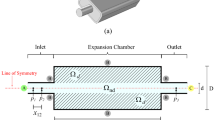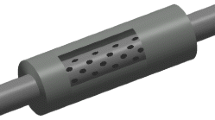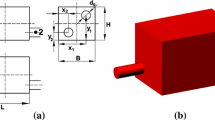Abstract
This article presents a topology optimization (TO) method developed for maximizing the acoustic attenuation of a perforated dissipative muffler in the targeted frequency range by optimally distributing the absorbent material within the chamber. The finite element method (FEM) is applied to the wave equation formulated in terms of acoustic pressure (chamber) and velocity potential (central duct, due to the existence of thermal gradients and mean flow) in order to evaluate the acoustic performance of the noise control device in terms of transmission loss (TL). Sound propagation through the chamber fibrous material is modeled considering complex equivalent acoustic properties, which vary spatially not only as a function of temperature but also as a function of the filling density, since non-homogeneous density distributions are considered. The acoustic coupling at the perforated duct is performed by introducing a coordinate-dependent equivalent impedance. The objective function to maximize is expressed as the mean TL in the targeted frequency range. The sensitivities of this function with respect to the filling density of each element in the chamber are evaluated following the standard adjoint method. The method of moving asymptotes (MMA) is used to update the design variables at each iteration of the TO process, keeping the weight of absorbent material equal or lower than a given value, while maximizing attenuation. Additionally, several particular designs inferred from the topology optimization results are analyzed. For example, the sizing optimization of a number of rings is carried out simultaneously with the aforementioned TO process (density layout). A reactive chamber is added in order to evaluate the TL of a hybrid muffler and its shape optimization is also carried out simultaneously with the aforementioned TO. Results show an increase in the muffler’s mean TL at target frequencies, for all cases under study, while the amount of absorbent material used is maintained or even reduced.



















Similar content being viewed by others
References
Allard JF, Atalla N (2009) Propagation of Sound in Porous Media: Modelling Sound Absorbing Materials. Wiley, Chichester
Antebas AG, Denia FD, Pedrosa AM, Fuenmayor FJ (2013) A finite element approach for the acoustic modelling of perforated dissipative mufflers with non-homogeneous properties. Math Comput Model 57:1970–1978
Atkinson KE (1989) An Introduction to Numerical Analysis. John Wiley & Sons, 2nd Edition
Azevedo FM, Moura MS, Vicente WM, Picelli R, Pavanello R (2017) Topology optimization of reactive acoustic mufflers using a bi-directional evolutionary optimization method. Struct Multidiscip Optim 58:2239–2252
Barbieri R, Barbieri N (2006) Finite element acoustic simulation based shape optimization of a muffler. Appl Acoust 67:346–357
Chang YC, Chiu MC (2008) Shape optimization of one-chamber perforated plug/non-plug mufflers by simulated annealing method. Int J Numer Methods Eng 74:1592–1620
Chiu M (2011) Optimization design of hybrid mufflers on broadband frequencies using the genetic algorithm. Arch Acoust 36:795–822
Christie DRA (1976) Measurement of the acoustic properties of a sound-absorbing material at high temperatures. J Sound Vib 46:347–355
De Lima KF, Lenzi A, Barbieri R (2011) The study of reactive silencers by shape and parametric optimization techniques. Appl Acoust 72:142–150
Delany ME, Bazley EN (1970) Acoustical properties of fibrous absorbent materials. Appl Acoust 3:105–116
Denia FD, Sánchez-Orgaz EM, Baeza L, Kirby R (2016) Point collocation scheme in mufflers with temperature gradient and mean flow. J Comput Appl Math 291:127–141
Denia FD, Sánchez-Orgaz EM, Martínez-Casas J, Kirby R (2015) Finite element based acoustic analysis of dissipative mufflers with high temperature and thermal-induced heterogeneity. Finite Elem Anal Des 101:46–57
Denia FD, Selamet A, Fuenmayor FJ, Kirby R (2007) Acoustic attenuation performance of perforated dissipative mufflers with empty inlet/outlet extensions. J Sound Vib 302:1000–1017
Denia FD, Selamet A, Martínez MJ, Torregrosa AJ (2006) Hybrid mufflers with short lateral chambers: analytical, numerical and experimental studies. In: 13th International Congress on Sound and Vibration (ICSV 13) Vienna
Fok VA (1963) in Russian. Alternatively, see S.N. Rschevkin, A course of lectures on the theory of sound, Pergamon, London
Ingard KU (1953) On the design of acoustic resonators. J Acoust Soc Am 25:1037–1061
Jensen JS (2012) Topology optimization. In: Romeo F, Ruzzene M (eds) Wave Propagation in Linear and Nonlinear Periodic Media. CISM Courses and Lectures, vol 540. Springer, Vienna
Kirby R, Cummings A (1999) Prediction of the bulk acoustic properties of fibrous materials at low frequencies. Appl Acoust 56:101–125
Kirby R, Denia FD (2007) Analytic mode matching for a circular dissipative muffler containing mean flow and a perforated pipe. J Acoust Soc Am 122:3471–3482
Kirby R, Williams PT, Hill J (2013) The effect of temperature on the acoustic performance of splitter silencers. In: 42nd International Congress and Exposition on Noise Control Engineering – INTERNOISE, 7, pp 5826–5833
Lee JS, Göransson P, Kim YY (2015) Topology optimization for three-phase materials distribution in a dissipative expansion chamber by unified multiphase modeling approach. Comput Methods Appl Mech Eng 287:191–211
Lee JW (2015) Optimal topology of reactive muffler achieving target transmission loss values: Design and experiment. Appl Acoust 88:104–113
Lee JW, Kim YY (2009) Topology optimization of muffler internal partitions for improving acoustical attenuation performance. Int J Numer Methods Eng 80:455–477
Lee SH, Ih JG (2003) Empirical model of the acoustic impedance of a circular orifice in grazing mean flow. J Acoust Soc Am 114:98–113
Munjal ML (2014) Acoustics of Ducts and Mufflers, John Wiley & Sons, 2nd Edn
Peat KS, Rathi KL (1995) A finite element analysis of the convected acoustic wave motion in dissipative mufflers. J Sound Vib 184:529–545
Pierce AD (1990) Wave equation for sound in fluids with unsteady inhomogeneous flow. J Acoust Soc Am 87:2292–2299
Rao SS (2011) The Finite Element Method in Engineering, Butterworth-Heinemann. 5th Edition
Sánchez-Orgaz EM (2016) Advanced numerical techniques for the acoustic modelling of materials and noise control devices in the exhaust system of internal combustion engines, Ph. D, Thesis, Universitat Politècnica de València
Selamet A, Lee IJ, Huff NT (2003) Acoustic attenuation of hybrid mufflers. J Sound Vib 262:509–527
Selamet A, Xu MB, Lee IJ, Huff NT (2005) Dissipative expansion chambers with two concentric layers of fibrous material. International Journal of Vehicle Noise and Vibration 1:341– 357
Selamet A, Xu MB, Lee IJ, Huff NT (2006) Effect of voids on the acoustics of perforated dissipative mufflers. International Journal of Vehicle Noise and Vibration 2:357–372
Sigmund O (2007) Morphology-based black and white filters for topology optimization. Struct Multidiscip Optim 33:401–424
Sigmund O, Maute K (2013) Topology optimization approaches. Struct Multidiscip Optim 48:1031–1055
Stolpe M, Svanberg K (2001) An alternative interpolation scheme for minimum compliance optimization. Struct Multidiscip Optim 22:116–124
Svanberg K (1987) The method of moving asymptotes - a new method for structural optimization. Int J Numer Methods Eng 24:359– 373
Williams PT, Kirby R, Malecki C, Hill J (2014) Measurement of the bulk acoustic properties of fibrous materials at high temperatures. Appl Acoust 77:29–36
Yedeg EL, Wadbro E, Berggren M (2016) Interior layout topology optimization of a reactive muffler. Struct Multidiscip Optim 53:645–656
Yoon GH (2013) Acoustic topology optimization of fibrous material with Delany–Bazley empirical material formulation. J Sound Vib 332:1172–1187
Zienkiewicz OC, Taylor RL, Zhu JZ (2005) The Finite Element Method: its Basis and Fundamentals. Elsevier Butterworth-Heinemann, Burlington
Zoutendijk G (1960) Methods of Feasible Directions. Elsevier, Amsterdam
Funding
The authors gratefully acknowledge the financial support of Ministerio de Ciencia, Innovación y Universidades–Agencia Estatal de Investigación and the European Regional Development Fund (projects TRA2017-84701-R and DPI2017-89816-R), as well as Generalitat Valenciana (project Prometeo/2016/007).
Author information
Authors and Affiliations
Corresponding author
Ethics declarations
Conflict of interest
The authors declare that they have no conflict of interest.
Replication of results
The optimized fibre density layouts relating to Designs 1-3 shown in Figs. 5, 11 and 14, are accessible in http://aim.upv.es/doc/SMO-TO-mufflers-replication-of-results.xlsx. Additionally, the TL prediction for Designs 1-4 shown in Figs. 7, 15, 16 and 19 respectively, are provided in numerical form in the same link.
Additional information
Responsible Editor: Anton Evgrafov
Publisher’s note
Springer Nature remains neutral with regard to jurisdictional claims in published maps and institutional affiliations.
Appendix: Differentiation of the global matrix κ with respect to the design variables
Appendix: Differentiation of the global matrix κ with respect to the design variables
In this appendix, the expressions of each of the components of κ are differentiated analytically with respect to each of the design variables considered in this study.
1.1 A.1 Calculation of ∂κ/∂ρb
Differentiating the global matrix κ in (54) with respect to the bulk density ρb assigned to the elements \(e=1,...,N^{e}_{\rho }\), one obtains:
where, according to (24), (25) and (33–37), the terms considered in order to build the global matrices are:
Using the equivalent acoustic properties detailed in (5) and (6), the derivatives of ρm and cm with respect to ρb can be obtained as:
whereas according to (3) and (4), it can be obtained:
Taking into account the thermal effects described in Christie’s power law recalled in (2), the derivative of the frequency parameter with respect to ρb is
On the other hand, differentiating (40), \(\partial \tilde {Z}_{p} / \partial \rho _{b}\) can be obtained as:
1.2 A.2 Calculation of ∂κ/∂Lx
In Section 5.3, rings of absorbent material are defined as areas with constant ρb, and the dimensions of these are also subject to modification. Cartesian element grids are implemented within each ring. For the elements within a certain ring, \(e=1,...,{N^{e}_{m}}\), and the elements within the corresponding duct zone underneath, \(e=1,...,{N^{e}_{a}}\), the velocity field at the element integration points due to the modification of the ring length Lx must be taken into account during the computation of the terms listed below:
1.3 A.3 Calculation of ∂κ/∂Lr
In order to compute the derivative of the chamber terms with respect to the chamber dimension Lr = Rc − Rt (see Figs. 3 and 17), the velocity field generated by ∂Lr must be taken into account, but also the axisymmetric integration effect must be considered when computing \(\partial \left (\text {d}\mathit {\Omega } \right ) / \partial L_{r}\). The terms are given by the expressions:
Rights and permissions
About this article
Cite this article
Ferrándiz, B., Denia, F.D., Martínez-Casas, J. et al. Topology and shape optimization of dissipative and hybrid mufflers. Struct Multidisc Optim 62, 269–284 (2020). https://doi.org/10.1007/s00158-020-02490-x
Received:
Revised:
Accepted:
Published:
Issue Date:
DOI: https://doi.org/10.1007/s00158-020-02490-x




